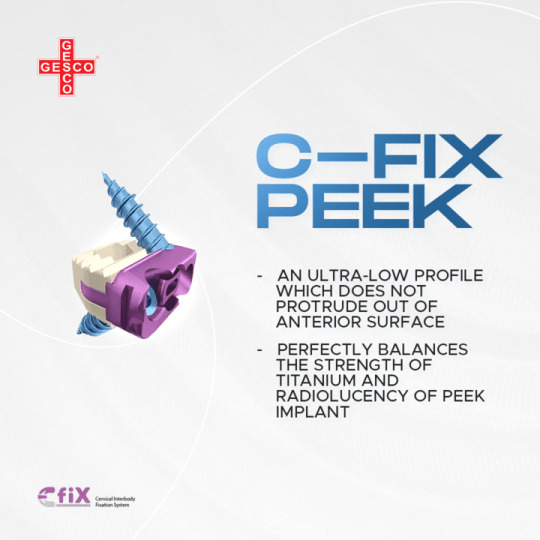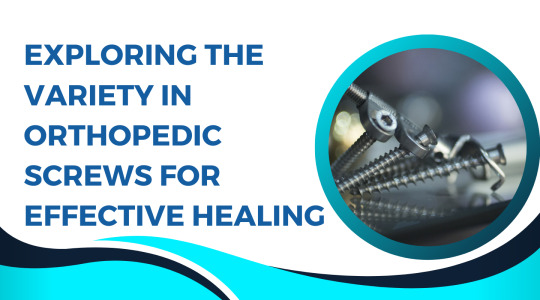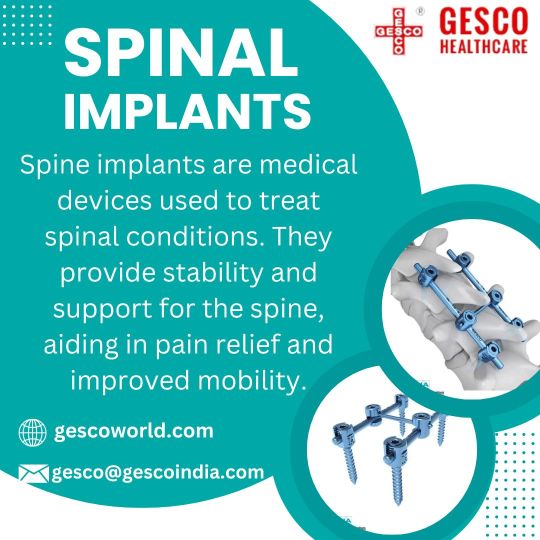Don't wanna be here? Send us removal request.
Text
peek cage
Introducing the C-FIX PEEK, a revolutionary leap in cervical interbody anterior cages that seamlessly blends innovation and functionality. This state-of-the-art implant is meticulously crafted with an integrated internal screw fixation, setting a new standard in anterior cervical discectomy and fusion (ACDF).

0 notes
Text
Surgical implants manufacturers
Surgical implants manufacturers produce a range of medical devices designed to be implanted into the body for therapeutic purposes. These companies adhere to stringent quality standards and regulations to ensure the safety and efficacy of their products, catering to various medical specialties such as orthopedics, cardiology, and dentistry.

0 notes
Text
spinal implants
A spinal implant is a medical device surgically placed in the spine to stabilize or support vertebrae, treating conditions like spinal deformities or injuries.
0 notes
Text
Neurosurgical Instruments
Precision-crafted neurosurgical instruments, vital for intricate procedures. Designed for accuracy, durability, and minimal tissue disruption in neurological surgeries.

0 notes
Text
Exploring the Variety in Orthopedic Screws for Effective Healing

Introduction:
Muscular screws assume a critical part in the field of muscular medical procedure, filling in as fundamental parts in the adjustment and obsession of cracked or harmed bones. The variety in muscular screw plans and materials has extended throughout the long term, giving specialists a scope of choices to fit medicines to individual patient necessities. This article expects to dive into the different sorts of muscular screws, their materials, and the progressions that add to compelling bone recuperating.
Customary Muscular Screws:
Customary muscular screws are commonly made of treated steel or titanium. Tempered steel screws are known for their solidarity and strength, making them reasonable for different applications. Titanium screws, then again, are esteemed for their biocompatibility and decreased hazard of erosion.
One of the regularly utilized conventional screws is the cortical screw, intended for obsession in thick bone. Another sort is the cancellous screw, highlighting a more extensive string design for improved buy in milder bone. These conventional screws have been dependable options for a long time, giving solidness and backing in muscular medical procedures.
Bioabsorbable Muscular Screws:
Bioabsorbable screws have acquired fame because of their interesting property of being progressively consumed by the body over the long run. These screws are frequently produced using materials like polylactic corrosive (PLA) or polyglycolic corrosive (PGA). The benefit of bioabsorbable screws lies in the end of the requirement briefly medical procedure to eliminate the equipment.
These screws are especially valuable in pediatric muscular health, where the embed will normally corrupt as the youngster develops. They likewise diminish the gamble of obstruction with imaging studies, making postoperative appraisals simpler.
Locking Muscular Screws:
Locking tightens give a particular component that upgrades steadiness obsession. These screws have strings intended to draw in with a plate, making a fixed-point develop. The locking highlight forestalls relative movement between the screw and the plate, further developing protection from slackening.
Locking screws are worthwhile in osteoporotic bone or circumstances where traditional screws may not give adequate dependability. This plan limits micromotion at the break site, advancing better mending results.
Variable Pitch Screws:
Variable pitch screws have a string plan that changes along the length of the screw. This variety in pitch considers various degrees of pressure at the crack site. Pressure is pivotal for advancing bone mending, and variable pitch screws offer a redid way to deal with accomplish the ideal pressure.
Specialists can pick the pitch variety in light of the particular prerequisites of the break, giving flexibility in the use of these screws. This flexibility is especially valuable in situations where a uniform pressure may not be reasonable.
Headless Screws:
Headless screws, otherwise called cannulated screws, miss the mark on noticeable head, which lessens the unmistakable quality of equipment underneath the skin. These screws are normally utilized in regions where delicate tissue bothering or noticeable quality of the embed may be a worry.
The cannulated plan takes into consideration percutaneous arrangement, limiting the obtrusiveness of the medical procedure. Headless screws are many times utilized in techniques like subtalar arthrodesis or cracks close to joints, where limiting disturbance is significant for ideal patient results.
Progressions in Material Science:
Material science plays had a huge impact in the development of muscular screws. While tempered steel and titanium stay conspicuous decisions, more current materials are being investigated for upgraded execution. Magnesium-based screws, for example, are being researched for their biocompatibility and potential to debase after some time.
Furthermore, progressions in surface coatings expect to further develop osseointegration, diminishing the gamble of embed disappointment. Hydroxyapatite-covered screws, for instance, work with better bone adherence, advancing quicker mending and lessening the gamble of non-associations.
Explored and Tweaked Screws:
With the coordination of PC helped route frameworks, specialists can now design and execute methodology with a more serious level of accuracy. Explored muscular screws consider constant following and direction, guaranteeing precise situation and ideal obsession.
Moreover, the idea of tweaked muscular inserts, including screws, is getting some forward movement. Patient-explicit inserts, planned in light of individual physical information, give a fitted way to deal with muscular mediations, possibly further developing results and decreasing entanglements.
Conclusion:
The assortment in muscular screws mirrors the unique idea of muscular medical procedure, where customized and creative methodologies are progressively pervasive. From conventional hardened steel screws to bioabsorbable other options, and from locking systems to variable pitch plans, each sort of screw fills a particular need in advancing viable bone recuperating. Headways in materials and innovation keep on pushing the limits of muscular development, promising improved results for patients going through careful mediations. As innovative work in this field progress, muscular specialists can anticipate an extending toolbox that considers more exact, patient-driven, and fruitful muscular systems.
0 notes
Text
Titanium Cage
Titanium Cage A robust and lightweight structure crafted from high-grade titanium alloy, seamlessly blending strength with minimal weight. Precision engineering ensures durability, making it ideal for aerospace, medical implants, and advanced technological applications.

0 notes
Text
Peek Cage
Peek Cage A cutting-edge immersive experience, blending virtual reality and escape room elements for a thrilling adventure in a confined digital realm.

0 notes
Text
surgical instruments
Top-grade surgical instruments crafted from high-quality materials, precision-engineered for accuracy, sterilizable, and designed for optimal surgical performance.
0 notes
Text
Best Surgical Instruments
Top-grade surgical instruments crafted from high-quality materials, precision-engineered for accuracy, sterilizable, and designed for optimal surgical performance.

0 notes
Text
Cervical cage
A cervical cage implant is a device used in spine surgery to stabilize the cervical vertebrae. It's inserted between vertebral bodies to restore height, alignment, and decompress nerves. Typically made of titanium or polymer, it promotes fusion while maintaining spinal stability.

0 notes
Text
Lumber Cage
Lumber Cage implant is a surgical device used to stabilize and support the spine, aiding in spinal fusion and reducing back pain.

0 notes
Text
Spine Implants
Spine implants are medical devices used to support and stabilize the spine, treating conditions like fractures, deformities, or disc problems.

0 notes
Text
Pedicle Screws
Pedicle screws are medical devices used in spinal surgeries to stabilize vertebral bones by attaching rods or plates for spinal fusion

0 notes
Text
Spine Cage
A spine cage is a medical implant used in spinal fusion surgeries to support and stabilize the spine, aiding in healing and alignment.

0 notes
Text
Peek Cage Implants
A peek cage implant is a medical device made of polyetheretherketone used in spinal surgeries to stabilize vertebrae, aiding in fusion. It provides structural support while allowing bone growth and integration due to its biocompatible properties.

0 notes
Text
Best Surgical Instruments
Precision-crafted surgical instruments designed for accuracy, durability, and optimal performance in diverse medical procedures.

0 notes
Text
Spine Implants
Spine implants are medical devices used to stabilize or replace damaged vertebrae to treat spinal conditions and improve mobility

0 notes